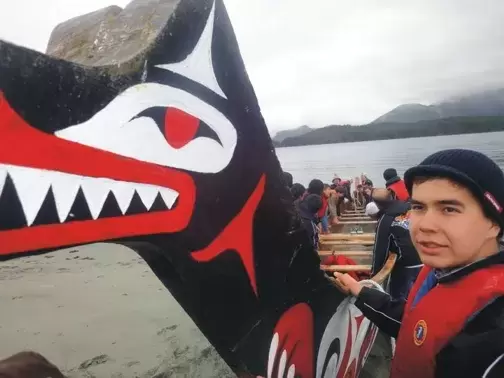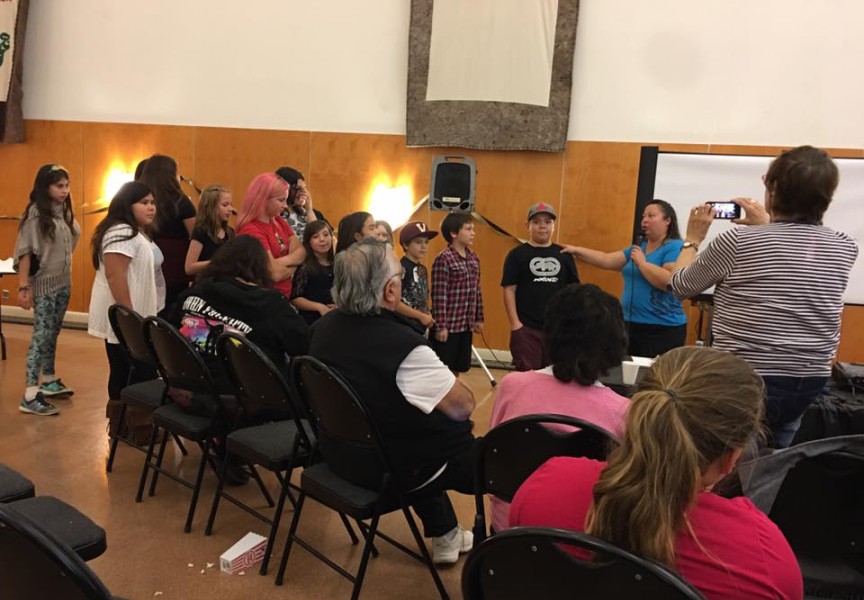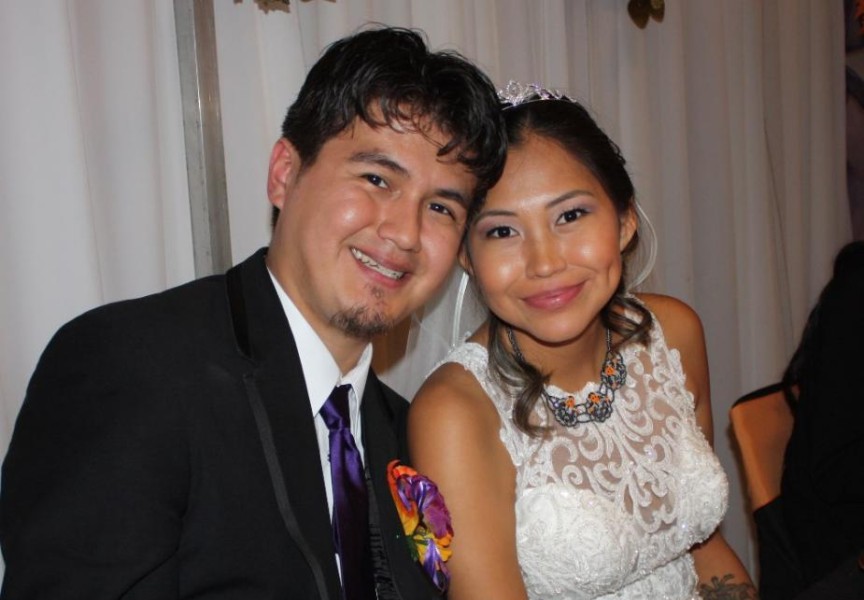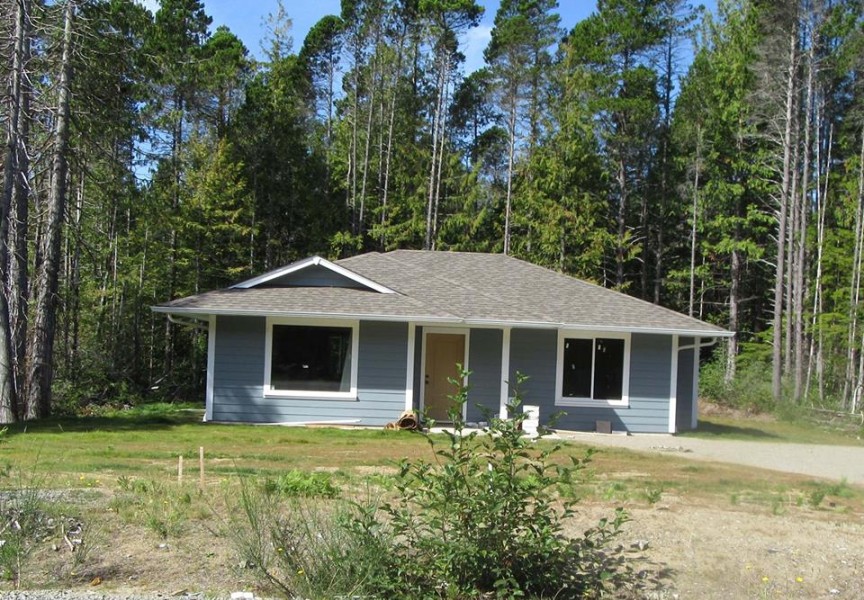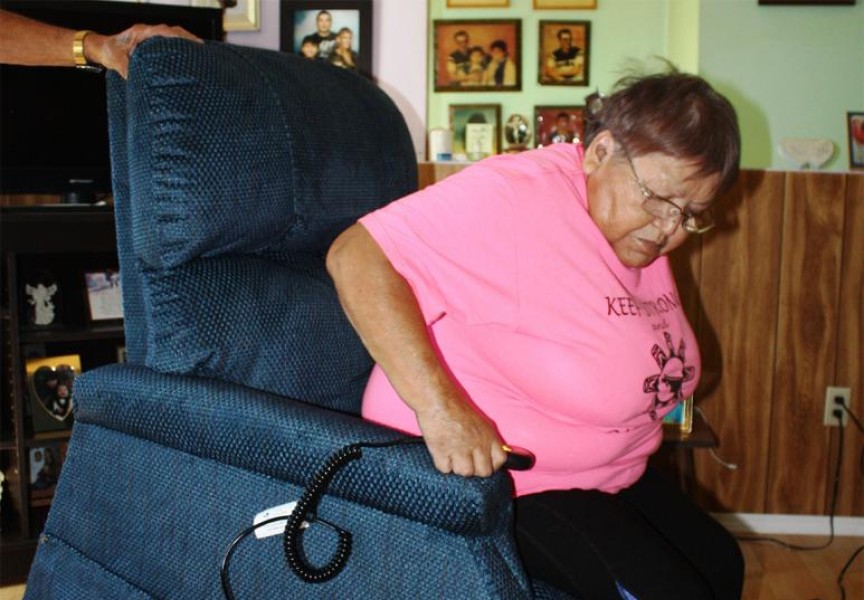By Michael McKinnon, and reprinted with permission from the Atikokan Progress
Thrilled. Exhausted. Profoundly moved.
Those four words just begin to describe the feelings of the 17 Atikokan High School (AHS) students who took part in the Ahousaht-AHS exchange. The students were back in class in mid-May, trying to return to a regular routine, with a little catching up dogging them as well. But it’s pretty clear every one of them was delighted with the experience.
It was eight very intense days. The students, over 30 of them as a group, hiked, camped, surfed, paddled, kayaked, swam, danced, and saw the sights. Most importantly, they bonded in a way that surprised them all. And those bonds are deepening still; their on-line social world has expanded, and the students remain in pretty much daily communication.
“There’s so much back and forth now; it’s just amazing,” said Kelly Duquette.
“We’ve talked a couple of times on the phone, and we stay connected on Facebook,” said Ruby Hall of Chelsea Campbell, with whom she was paired in both communities.
“Am I friends with Peter? [Campbell, his host in Ahousaht] He’s family,” said Troy Thurier.
“It really sucked saying goodbye… I cried about it all coming to an end,” said Megan Cain. “But I know I’ve made friends I’ll keep for the rest of my life.”
The billeting arrangements, in most cases, were the same in both communities, and that helped cement many friendships, and also made the stay away from home easier. But the stay in a ‘strange’ home wasn’t really an issue for anyone.
“They were very welcoming,” said Brodie Matichuk, who stayed with Destiny John. “Mom and dad [there] were kind of like my mom and dad. And they had a little sister the same age as mine (4)… that was pretty interesting.”
“I liked it – it was homey,” said Russell Maki, who stayed with two others at Timothy Little’s home.
“They just adopted me into their home,” said Michelle Menson, who stayed with Tracy Frank. “I was talking with her mom yesterday and she said ‘Oh, the house is so empty without you’. They’ve invited me back, and wanted me to know I will always have a place to stay. I’d love to go back.”
And that warm welcome was extended by the whole community to all of the visitors.
“I wasn’t so sure at first that this would be a good place to go. But when we got there, there were people waiting for us on the dock, and everyone talked to you, just like in Atikokan,” said Menson.
“It seemed like the whole town knew us. Anywhere we went, people would say hi, often even knowing us by name,” said Amanda DeCorte.
“The community was just so welcoming, it made me start to wonder: Did we do as good a job giving them that sort of welcome?” said Calvin Hayes. “I hope so… I think we did.”
The schedule was jam-packed. Most days started pretty early, and didn’t end until about ten in the evening. And as often as not, there was a lot of socializing and sharing then, as the students processed all the new experiences.
The students spent one day at school, which included a welcoming assembly. Ahousaht currently has one joint elementary-secondary school; a new high school is being built, and should be ready for next year. The community has a population of 1,000 to 1,400 living in about 170 households, most of them at the main settlement of Maaqtisiis, where the school is located. That’s on Flores Is., a good-sized (150 sq. km.), mountainous island about a 45-minute boat ride from Tofino, on the west side of Vancouver Island.
It is very isolated. When they were here, the Ahousaht students were impressed with Atikokan’s shopping and other amenities, which shocked the AHS students – until they got to Ahousaht.
“They don’t really even have a convenience store. They go to Nanaimo for just about everything,” said Ruby Hall.
The people are Nuu-chah-nulth, which translated from their language means ‘all along the mountains’. They were the original settlers of Canada’s southwestern coast. Like most Aboriginal peoples, their numbers were decimated within a hundred years of the arrival of Europeans. Today, there are 15 Nuu-chah-nulth Nations along the coast. In 2006, the Nuu-chah-nulth Tribal Council put the total population at 8,147; Ahousaht FN is the most populous.
Whale hunting plays a central role in their history, culture and spirituality. The students were introduced to that tradition at the community gathering, where the chief and elders recounted the people’s story, using a giant screen covered in traditional art and symbols.
As part of welcoming the visitors, the people danced, and with Liam Manford and Michelle Menson leading the way, the AHS students joined in. Michelle is a veteran of Anishnabe Pow-Wows, and her host family recruited her to dress and dance with the Ahousaht women. Liam joined in spontaneously, and was later called to the stage by the elders, who presented him with a copy of Living on the Edge, a Nuu-chah-nulth history told from the perspective of an Ahousaht Chief, Earl Maquinna George.
It was likely more than initiating the AHS participation in the dance that earned Manford that honour. He billeted with Peter Campbell, who shares a home with his grandmothers, and Manford spent a good deal of time talking with them.
“They are both artists; one is a carver,” he said. He a great time with them.
“You have so many pre-conceived ideas [when you go to a different place], but we learned pretty quickly that the people are pretty much the same as here. The community does have its problems, and they often have a hard time – but there are just so many really great people there.”
There is more than the big traditional beliefs that made the Ahousaht experience different; there were a lot of smaller, ‘way of doing things’, that were different, and noticed.
“They have community vehicles that people take and drive to where they are going and then just leave,” said Calvin Hayes. “And there are community dogs; they don’t bark, they don’t bite, they just follow you around.”
The food, too is different. Fresh seafood is a novelty for those of us living in the middle of the continent, and for the students whose past experiences were solely with frozen seafood, the new staple was appreciated.
The omnipresent ocean, mountains and rainforest meant the students were always aware they were in a very different place. And the connections they made helped them share in the reality of this different place and different culture.
Since planning with the students began, teacher and exchange organizer Peter Burton has emphasized the opportunity they were being presented. It paid off. “The exchange gave us the chance to really be with a different culture; we weren’t spectators,” he said.
“One of the kids came into class the first day back and just stood there for a minute. ‘I feel different’ he said, right out of the blue.”
That feeling of being just not quite able to express the impact of the experience was evident in all of the students. They all know the world has changed for them, and are curious and excited to understand the change and see exactly what it will mean in their lives.
“I know we planted some seeds with this exchange,” said Burton. “So much of the real value of what we experienced is resonating… It will take years to really show its full value.”
Activity-wise, the ocean took centre stage. They saw sea lions and whales almost right away. On the trip over to Ahousaht from Tofino, they followed a whale watching boat for a spell and got sight of several of the giant sea mammals.
Surfing was a hit with everyone. Surf Sisters (thus the pink-topped wet suits, which went over well with the guys) outfitted the crew and introduced them to the basics of the sport. Although the results performance-wise were pretty mixed, the experience was a delight.
“I was only able to get onto my knees [on the board], and I got tired just trying to get out far enough to catch the good waves,” said Amanda DeCorte
“I got up on my fourth try; it was actually easy once you got the hang of it,” said Brodie Matichuk. The experience was new to most of the Ahousaht students, as were a number of the week’s activities. (The same was true, of course, for the AHS kids on the Atikokan leg of the exchange.)
“I wasn’t able to get up on the board; but I just loved being in the waves, in all that movement,” said Taylor Veran. “The hot springs and the surfing were my favourites.”
The trip to the hot springs involved a trail hike, after a ride on the Ahousaht Pride, the water taxi that serves the community. They went at least part of the way on the Walk on the Wild Side, a noted Flores Island trail.
“The trail through the rain forest… it was pretty wild,” said Dylan Stewart. “The hot springs were a series of small ponds, that got colder the closer to the ocean you got.”
The students also got to try their hand at sea kayaking, paddling in pairs from Meares Island to the Tofino dock, and to take out the traditional Ahousaht canoe, with its animated bow.
The weather was mostly excellent, although it was rather cool and windy for their overnight camping trip; they were aiming for fourth beach (from Maaqtisiis), but had had enough hiking by the time they got to third beach, where they set up.
“It was way better than Outers,” said Sam, who was wowed by the rain forest, ocean and beaches. The whole experience has got her considering that maybe the West Coast wouldn’t be a bad place to head to for work or further schooling. “It was just like Outers – our tent was on a stump and a slope,” said Natasha Morrissette with a laugh. She loved the whole experience, however, and the only sleep difficulty was finding time.
“The whole time was so hectic. At one point, I didn’t sleep for 24 hours, and ended up falling asleep on the couch.” There was a basketball re-match, which the hosts won. “They play a lot of basketball here,” said Dylan Stewart. (In Atikokan, it took overtime for Ahousaht to win.)
For both groups of students, the exchange provided an introduction into a whole new world, in terms of geography, lifestyle and culture. And it provided that introduction in a manner that respected the skills and limits of the young people, while at the same time challenging them. Most importantly, it left them with a new appreciation for others, and their ability to reach across ordinary boundaries.
“At first, I didn’t know what to think about this exchange. But it sure helped to know that everyone was going through it,” said Natasha Morrissette.
“It took a couple days to start feeling comfortable, but we did get to it,” said Jordan Gagne. “I enjoyed it all, even just talking and hanging out. I’d just love to live there.”

